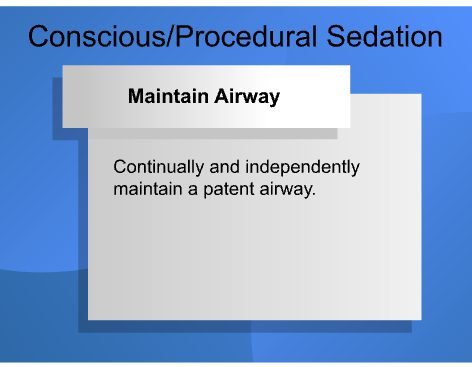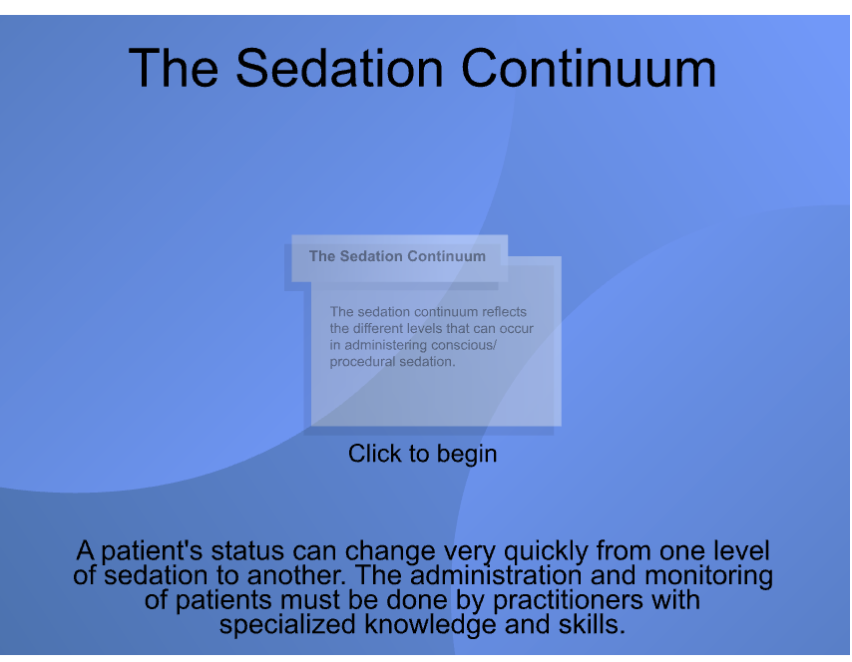Description #
Overview of the definition, practice, indications for and the role of the Nurse in regards to the administration and care of patients receiving Procedural Sedation and Analgesia.
Learning Objectives #
At the end of this module the student must be able to:
- Identify the key components that define the term “Procedural Sedation and Analgesia”
- Describe the goals of Procedural Sedation and Analgesia
- Identify the indications for administration of sedation
Unit introduction #
RECOMMENDED READINGS:
American Society of Anesthesiologists. (2001). Practice guidelines for sedation and
analgesia by non-anesthesiologists. An updated report by the American Society of
Anesthesiologists Task Force on Sedation and Analgesia by Non-Anesthesiologists.
Kobs, Ann. (1997). “Conscious sedation”. Questions about the anesthesia continuum. [In questions and answers from the JCAHO]. Nursing Management, 28(4), p. 14 & 17.
Kost, Michael. (2004). Moderate sedation / analgesia: Core competencies for practice
PSA-001: Introduction, Goals And Indications For Administration Of Sedation #

INTRODUCTORY INFORMATION
- Same-day discharge surgery has become increasingly popular as procedures can be performed with equal efficiency and safety without the cost and inconvenience of a hospital admission
- Many procedures that have traditionally been inpatient procedures are now being done on an outpatient basis
- Procedural Sedation is being used increasingly for both outpatient and inpatient procedures
- It allows for the comfortable provision of diagnostic and therapeutic interventions within a short time frame
- Many of these diagnostic and interventional procedures are done using endoscopic, percutaneous, or arthroscopic techniques which are uncomfortable but require the patient to be awake and cooperative
Procedural Sedation and Analgesia or commonly known as PSA is achieved by using some of the same medications and delivery methods as those used for anesthesia and deep sedation
The risks associated with general anesthesia can be avoided and the patient’s hospital stay can usually be decreased
- PSA allows the patient to be relaxed and comfortable during the procedure while remaining responsive to communication
PSA allows the patient to continually and independently maintain a patent airway and respond appropriately to verbal commands and / or gentle stimulation
- It does not refer to medications given for postoperative pain relief, pre-medication, or pain control during Labor and Delivery
- The ability to independently maintain a patent airway is an important distinguishing feature of PSA (VERY IMPORTANT!!!)
Another type of sedation, Deep Sedation or Monitored Anesthetic Care (MAC), uses medication to induce a controlled state of depressed consciousness or unconsciousness in which the patient may experience partial or complete loss of protective reflexes including the ability to independently and continuously maintain a patent airway
- The deeply sedated patient may not be easily aroused and may not purposefully respond to verbal commands or physical stimulation
***In VCHA, for procedures where deep sedation is a planned or probable outcome, the patient must be monitored with an ETCO2 monitor
- It should be recognized that various degrees of sedation occur on a continuum
- A patient may progress from one degree of sedation to another depending on many factors, including underlying medical status, the medication(s) administered, pre-medication, and so on
- It is therefore important that the monitoring and staffing requirements be based on the patient’s acuity and the potential response to the procedure
Progress from one level of sedation to another requires appropriate changes in monitoring and care of the patient
- It has been shown that many of these procedures (see indications) can be performed safely and comfortably if done in conjunction with an RN educated in the administration of sedation / analgesia
The responsibilities of those care providers (physician/RN/RT) administering PSA include the preparation, assessment, and monitoring of the patient before, during, and after the procedure
Informed and written consent must be obtained prior to the procedure and prior to the patient receiving sedating medication
For outpatient procedures, discharge and follow-up instructions should be provided verbally to the patient (and / or designate) prior to the administration of sedation and reinforced with both verbal and written instructions following the procedure
Indications for Procedural Sedation and Common procedures #
INDICATIONS:
PSA shortens procedural / medication recovery time and reduces the risks associated with general anesthetics, making it an increasingly popular option for many diagnostic / interventional procedures
The main goal of PSA is to chemically induce a state to help the patient relax, remain comfortable, and cooperate during the procedure
The following clinical situations are some examples of common diagnostic and interventional procedures which can be effectively completed with the use of intravenous PSA
COMMON PROCEDURES:
- Synchronized cardioversion
- Transesophageal echocardiograms
- Angiography and intervention
- Endoscopic procedures
- GI / GU tube insertion / changes
- Debridement of wounds
- Painful dressing changes
- Extensive laceration repair
- Lumbar punctures
- Closed reduction of fractures / dislocated joints
- Bone biopsies
- Removal of foreign bodies
- Short surgical / dental procedures
- Obstetric/gynecological procedures (IVF
The Role of the RN/RT #
Health care providers monitoring the sedated patient must demonstrate knowledge of:
- Anatomy and physiology
- Cardiac rhythm monitoring
- Assessment and monitoring pre / during / post procedure
- Patient / designate education
- Administration of drugs producing sedation / analgesia under the supervision of a responsible physician
- Documentation
- Knowledge of Pharmacology, particularly of sedation / analgesia medications and reversal agents, but also including potential interacting drugs
- Emergency management
- The necessary skills to assess, diagnose, and treat any complications that may arise
- Every practitioner has a responsibility to understand the benefits, risks, and potential adverse outcomes for the patient associated with the use of PSA

Goals and Desired effects of Procedural Sedation and Analgesia (PSA) #
GOALS OF PSA
To alleviate the patient’s anxiety and apprehension and to maximize their levels of tolerance and comfort before, during and after the procedure
DESIRED ENDPOINT OF PSA:
- Reduced fear and anxiety before the start of the procedure
- Relaxation and cooperation
- Intact protective reflexes-airway, swallowing, talking
- Easy arousability
DESIRED EFFECTS OF PSA
- Minimal or no pain
- Minimal variation in vital signs
- Lack of recall
- Rapid, safe return to activities of daily living
Indications of adequate Procedural Sedation and Analgesia #
INDICATIONS OF ADEQUATE PSA
- Visible relaxation
- Diminished verbal communication, diminished watchfulness
- Slow even respirations
- Arousal sleep – easily aroused when asleep
- Overall comfort and sedation which allows performance of procedure
Interactive Material -Sedation Continuum #

Sedation Continuum #
SEDATION CONTINUUM OF PSA
Sedation occurs on a continuum. The patient’s age, height and weight, present medical condition, health history, medications, mental status, pre-medication state (self-medicated / prescribed / illicit) may interact with the medications used to induce procedural sedation, resulting in deterioration along the sedation continuum.
Because the patient’s status can change very quickly from light to deep sedation / anesthesia, administration of procedural sedation and patient monitoring must be done by practitioners with specialized knowledge and skills.
LIGHT SEDATION
- Lowered anxiety / fear
- Cooperative, able to verbally communicate
- Intact protective reflexes
- No amnesia
PROCEDURAL (MODERATE) SEDATION
- Arousable, cooperative
- Respond to verbal stimulation
- Intact protective reflexes
- Speech may be slightly slurred
- Minimal variation in vital signs
- May be amnesia
DEEP SEDATION
- Not able to cooperate, not responding to verbal command or physical stimulation
- Eyes closed, speech severely slurred
- Vital signs more labile
- Amnesia
- Weak or absent protective reflexes
ANESTHESIA
- Unconscious
- Unresponsive to all stimuli
- Absent protective reflexes
- Vital signs labile
Procedural Sedation and Analgesia in Specialty Areas (Maternity and Pediatrics) #
PSA IN SPECIALTY AREAS (MATERNITY AND PEDIATRICS)
- Pediatrics
- Maternity
**The definition and indications for PSA is the same
for all patient care areas**
- It is the use of medication to achieve a depressed level of consciousness which allows for the tolerance of diagnostic / interventional procedures while sustaining the ability to independently and continually maintain a patent airway and respond appropriately to physical stimulation
- However, it must be acknowledged that specialty areas, such as pediatrics and maternity, encompass unique patient populations who are generally cared for by nurses with specialized knowledge and skills distinctive to those areas. Therefore, practitioners who work in those areas will cover Procedural Sedation in pediatrics and maternity in separate units for use
IMPLICATIONS OF PSA
- The use of PSA causes an alteration in the patient’s physical and mental status
- The RN must be familiar with, and prepared for, both desired and undesired effects associated with the administration of analgesia and sedation which safely allow for the provision of painful procedures
- It also requires a thorough pre-assessment as well as continuous monitoring of the patient during and after the procedure
REQUIREMENTS
- An awareness of practice guidelines [institutional policies / standards, CRNBC guidelines]
- Knowledge encompassing the use of PSA [goals, pharmacology, sedation levels, airway management, cardiovascular monitoring, patient assessment pre / during / post, emergency response, CPR]
- Knowledge regarding location and use of safety equipment [suction, bag-valve mask, crash cart and reversal agents]
Procedural Sedation: Video of patient scenario for short procedures less than 20 minutes.
Video of patient scenario for procedures more than 20 minutes.
Objective review #
OBJECTIVE REVIEW
You have now completed the Intoduction unit content, and you should now be able to meet the following objectives:
a) Identify the key components that define the term “Procedural Sedation and Analgesia
(PSA)”
b) Identify the indications for administration of sedation
c) Describe the goals of Procedural Sedation and Analgesia
Now that you have completed the Introduction Unit please complete the following (Click on the blue links below or they are located in the Unit Resources):
a) Tests & Evaluations –Unit Post-test
The questions are multiple choice – all questions are derived from the required readings and online content. Review the questions and your answers carefully prior to submitting – only one submission is permitted. Scores will be released immediately after submission.
b) Tests & Evaluations – Complete Unit evaluation
Now that you have completed the Introduction unit, please take a few moments to complete this evaluation form. Your comments are useful in shaping the development of the units so that future classes may benefit. The units also provide a lasting source of reference material for all past and present students. Thank you for your participation.
